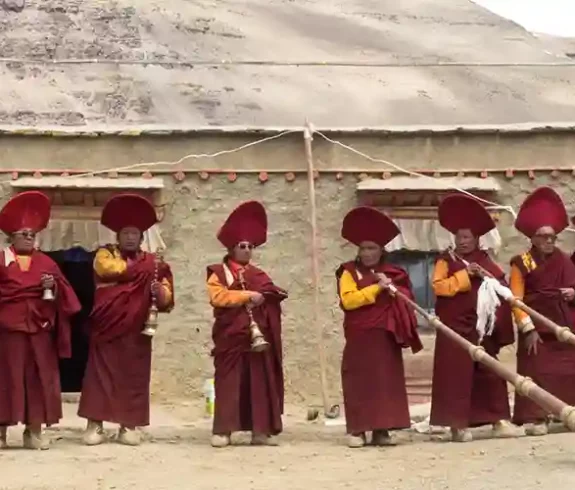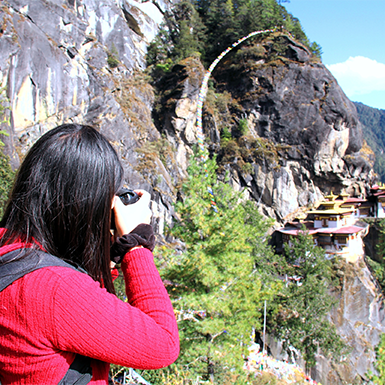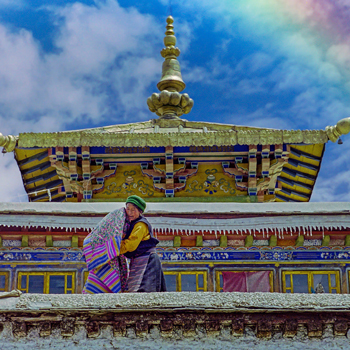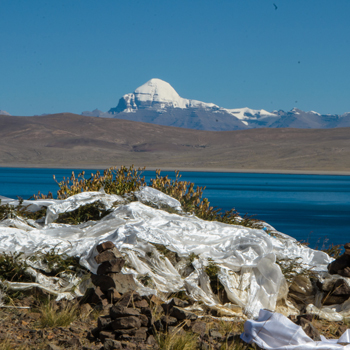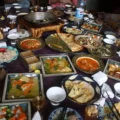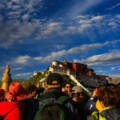Tibetan festivals are vibrant celebrations with a tapestry of Tibetan culture and traditions. These events, held throughout the year, offer a captivating glimpse into the Tibetan people’s religious beliefs, artistic expressions, and rich history. Whether planning a trip to Tibet or simply curious about this unique culture, understanding the Tibet festival will enrich your appreciation.
The Tibetan people place great importance on festivals. They serve as a platform for communities to unite, commemorate their past, and honor their spiritual values. Each festival boasts unique customs, ranging from colorful prayer ceremonies and theatrical performances to thrilling horse races and joyous feasts.
This article provides a comprehensive guide to Tibetan festivals. We’ll delve into some of the most prominent celebrations, including the Losar festival (Tibetan New Year), Saga Dawa celebrations, Monlam, and Shoton festivals. By exploring these events, you’ll gain valuable insights into Tibetan culture and traditions, making your understanding of this fascinating region even more profound.
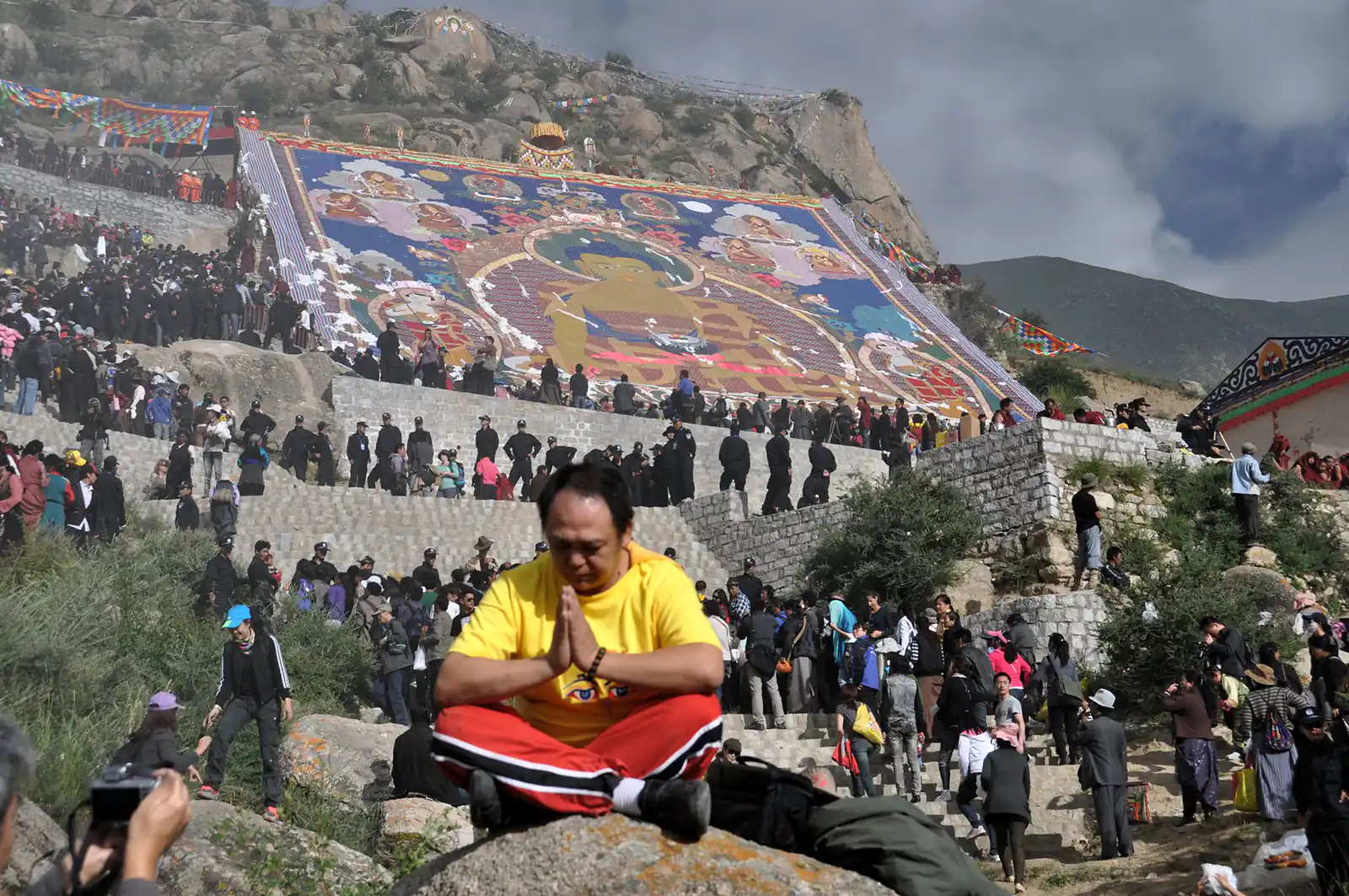
Historical and Cultural Background of Tibetan Festivals
Tibetan festivals boast a rich history, deeply woven into the very fabric of Tibetan culture and traditions. These vibrant celebrations extend beyond mere entertainment, serving as a platform to commemorate significant events, honor spiritual figures, and observe religious practices. Understanding Tibetan culture’s historical and cultural background is essential to fully appreciate it.
Ancient Roots
The origins of Tibetan festivals can be traced back centuries, with some celebrations believed to predate the introduction of Buddhism. These early festivals often coincided with agricultural cycles, giving thanks for harvests and petitioning for future bounty.
The Profound Influence of Tibetan Buddhism
Tibetan festivals underwent a dramatic transformation with the introduction of Buddhism in the region during the 7th century CE. Buddhist teachings and practices became intricately intertwined with existing traditions, shaping the festivals we see today. Significant events in the life of Buddha, such as his birth, enlightenment, and passing, became central themes for celebration. Monasteries emerged as pivotal centers for festival activities, hosting elaborate ceremonies and public displays.
A Celebration of Culture and Faith
Over time, Tibetan festivals evolved into cherished community gatherings. They fostered social connections and a shared sense of identity among Tibetans. Today, Tibetan culture continues to serve as a powerful expression of Tibetan culture and traditions. They are a time for families to reunite, communities to bond, and for the faithful to demonstrate their devotion to their religion.
The Role of Tibetan Buddhism
Tibetan Buddhism remains a defining force that shapes Tibetan festivals. Many festivals revolve around essential figures and events in Buddhist history. Here are some examples:
- Losar, the Tibetan New Year, coincides with the birthday of Tsongkhapa, the founder of the Gelugpa school of Tibetan Buddhism.
- Saga Dawa, which marks Gautama Buddha’s birth, enlightenment, and Parinirvana (passing), is regarded by Tibetan Buddhists as the holiest month.
- Monlam Prayer Festival features prayer ceremonies and debates held by monks, reflecting the importance of monastic practice in Tibetan Buddhism.
A Celebration of Culture: Unveiling Major Tibetan Festivals
Tibetan festivals are a vibrant tapestry woven from religion, tradition, and community spirit. These celebrations punctuate the calendar, offering a glimpse into the heart of Tibetan culture and traditions. This guide explores some of the most prominent Tibetan cultures, allowing you to appreciate their unique character.
1. Losar: Ushering in a Joyous New Year
Losar, the Tibetan New Year, takes center stage. Celebrated over 15 days in February or March, Losar signifies a fresh start and renewal. Its roots trace back to pre-Buddhist times, but with the arrival of Buddhism, it became associated with the birthday of Tsongkhapa, founder of the Gelugpa school.
A Look at Losar Festivities
Losar explodes with color, music, and tradition. Here’s a peek into the essential rituals:
- Guthuk: Families gather to prepare a special dough filled with symbolic ingredients predicting fortunes for the year ahead.
- Losar Eve: People decorate their homes and enjoy a traditional feast with their families. They burn effigies symbolizing the old year to cleanse negativity.
- New Year’s Day: Monks clad in colorful robes perform blessings. People exchange greetings, offer prayers, and visit monasteries. Traditional music and dances fill the air.
- Following Days: Festivities continue with opera performances, horse races, and archery competitions. Visits with relatives and friends strengthen social bonds.
A Culinary Adventure
Food is a central feature of Losar. Expect delectable treats like:
- Khapse: Deep-fried pastries filled with sweet or savory ingredients.
- Drocha: A hearty noodle soup.
- Chang: A barley beer enjoyed during social gatherings.
Losar Festival Date
| Year | Losar Festival date |
| 2025 | February 28 |
| 2026 | February 18 |
| 2027 | February 7 |
| 2028 | February 26 |
| 2029 | February 14 |
| 2030 | March 5 |
2. Saga Dawa
Saga Dawa, the holiest month in Tibetan Buddhism, holds immense significance within Tibetan culture and traditions. Celebrated in May or June, this month transcends a typical festival, transforming into a sacred period dedicated to commemorating the life of Gautama Buddha. Let’s explore how Tibetans profoundly observe Saga Dawa.
A Month of Deep Reverence
Saga Dawa is a time for heightened devotion and spiritual reflection. Here’s a glimpse into how Tibetans observe this sacred period:
- Increased Piety: Devotees adhere to stricter vegetarian diets and abstain from harming living creatures. This practice reflects the Buddhist principle of non-violence (ahimsa).
- Pilgrimages to Sacred Sites: Many Buddhists undertake trips to revered pilgrimage sites, particularly Lhasa, the historic capital of Tibet. These pilgrimages hold the potential to accumulate merit, a concept signifying positive karma.
- Prayers and Ceremonies: Monasteries become vibrant hubs of activity, hosting elaborate prayer ceremonies, teachings, and Dharma talks throughout the month.
A Time for Inner Peace and Collective Merit
Saga Dawa transcends individual practice, fostering a sense of collective merit-making. Public displays of devotion are expected, with prayer flags adorning mountainsides and devotional chants echoing through valleys.
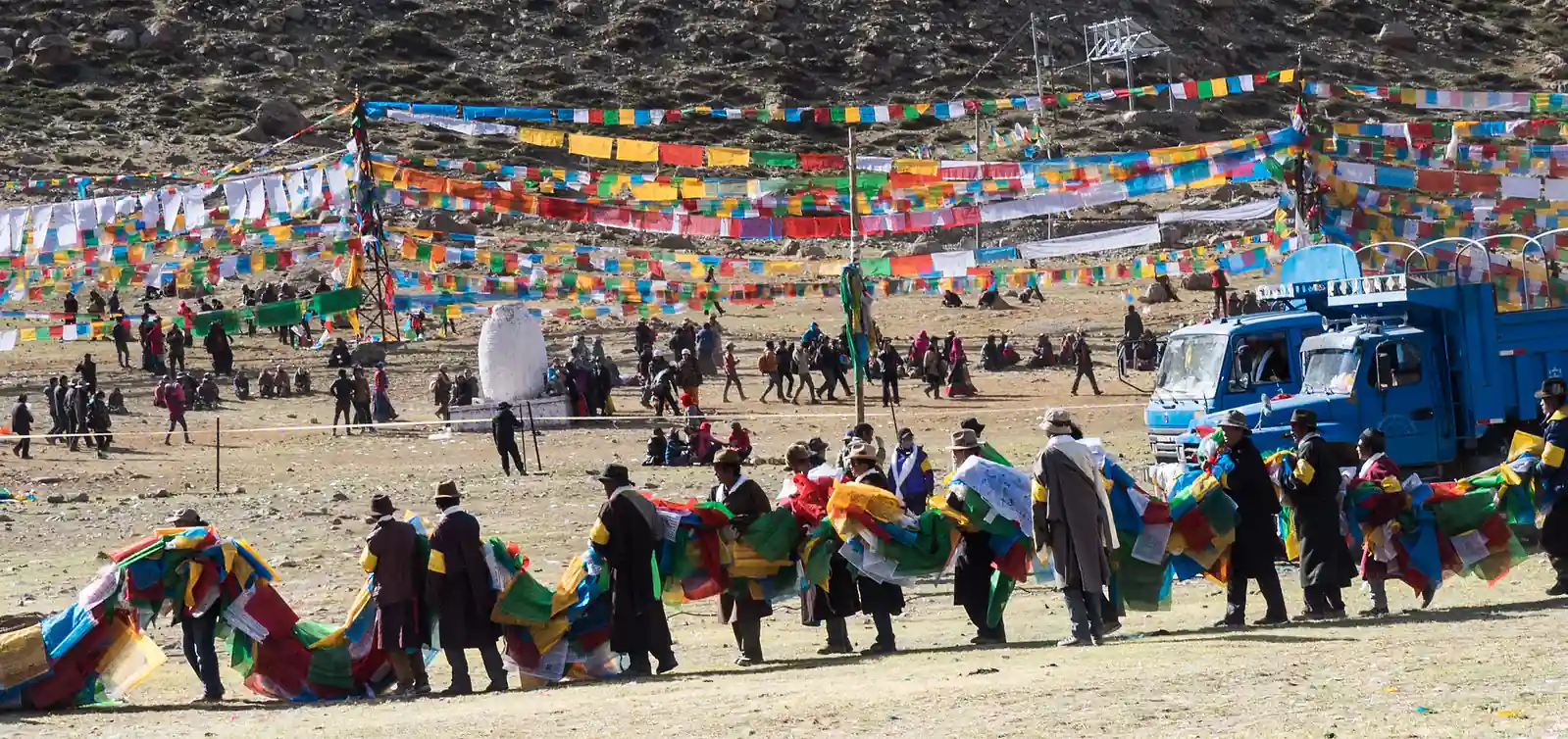
Witnessing Saga Dawa
If you’re fortunate enough to be in Tibet during Saga Dawa, expect a serene and contemplative atmosphere. While some public celebrations might be limited, monasteries remain open for visitors to witness prayer ceremonies and experience the profound reverence of this sacred month.
Saga Dawa Festival Date
| Year | Losar Festival date |
| 2025 | June 4 |
| 2026 | May 31 |
| 2027 | June 18 |
3. Monlam (Great Prayer Festival)
Tibetan festivals are a vibrant tapestry woven from religion, tradition, and community spirit. Every festival provides another look into the core of Tibetan customs and culture. Among these, the Monlam, also known as the Great Prayer Festival, stands out as a grand display of monastic activity, public participation, and unwavering faith. The 2025 Monlam Festival will be held from March 3 to March 25.
A Legacy of Peace and Merit-Making
The Monlam boasts a rich history, dating back to the 15th century. Tsongkhapa, the founder of the Gelugpa school of Tibetan Buddhism, instituted the celebration to appease a furious spirit thought to be the source of illness. Over time, it evolved into a celebration of peace, prosperity, and the accumulation of merit, a concept signifying positive karma in Tibetan Buddhism.

A Month of Spiritual Dedication
Held traditionally in Lhasa during the cold winter months, the Monlam unfolds over two weeks. Here’s a look at what you can expect:
- Monastic Debates: Scholarly monks engage in lively philosophical debates on Buddhist scriptures and commentaries. These debates showcase their knowledge and interpretation of Buddhist teachings, creating a stimulating intellectual atmosphere.
- Public Prayers: Thousands of devotees from surrounding areas gather in Lhasa to participate in group prayers and mantra recitations. This collective act of devotion reinforces the importance of community in Tibetan Buddhism and creates a powerful sense of shared faith.
- Elaborate Ceremonies: Monks perform special pujas (ritual offerings) and blessings throughout the festival. These ceremonies are often visually stunning, featuring intricate mandala creations, chanting, and the rhythmic sounds of traditional instruments.
Witnessing the Monlam
While the Monlam is primarily a religious observance, visitors are welcome to witness certain aspects of the festival. If permitted, observing the public prayers or attending a puja ceremony can be a truly unforgettable experience. The vibrant energy of Lhasa during this sacred time is palpable, offering a glimpse into the deep devotion that characterizes Tibetan culture.
4. Shoton: A Festival Steeped in History and Tradition
The Shoton Festival, or Yogurt Festival, occurs in August and marks the end of the summer monastic retreat. This lively festival boasts a rich history with roots in agricultural practices but has evolved into a celebration of:
- Open-Air Opera Performances: A major highlight of Shoton is elaborate, week-long opera performances depicting historical and mythological stories. These open-air performances create a festive atmosphere and showcase traditional Tibetan music and dance.
- Yogurt Offerings: A critical tradition involves offering bowls of yogurt to monks. This practice symbolizes the conclusion of their retreat and their return to dairy products.
- Public Festivities: The festival culminates in a joyous public gathering filled with picnics, traditional games, and energetic folk dances. This lively atmosphere reflects the spirit of community and shared enjoyment.
- 2025 Date: The 2025 Shoton Festival will be held on August 23.
5. Ganden Thangka Festival: A Spectacle of Faith
Held every few years at the Ganden Monastery, the Ganden Thangka Festival showcases a massive embroidered thangka (Tibetan scroll painting) depicting Gautama Buddha. This spectacular event serves as:
- A Commemoration: The festival commemorates the founding of the Ganden Monastery in the 14th century, highlighting its historical significance within Tibetan Buddhism.
- Thangka Unfurling: A giant thangka, often measuring several stories high, is dramatically unfurled on a mountainside for public viewing. This grand display serves as a powerful symbol of faith and devotion.
- Religious Ceremonies: Monks perform special prayers and blessings throughout the festival, further enriching its spiritual significance.
- Religious Ceremonies: August 9, 2025
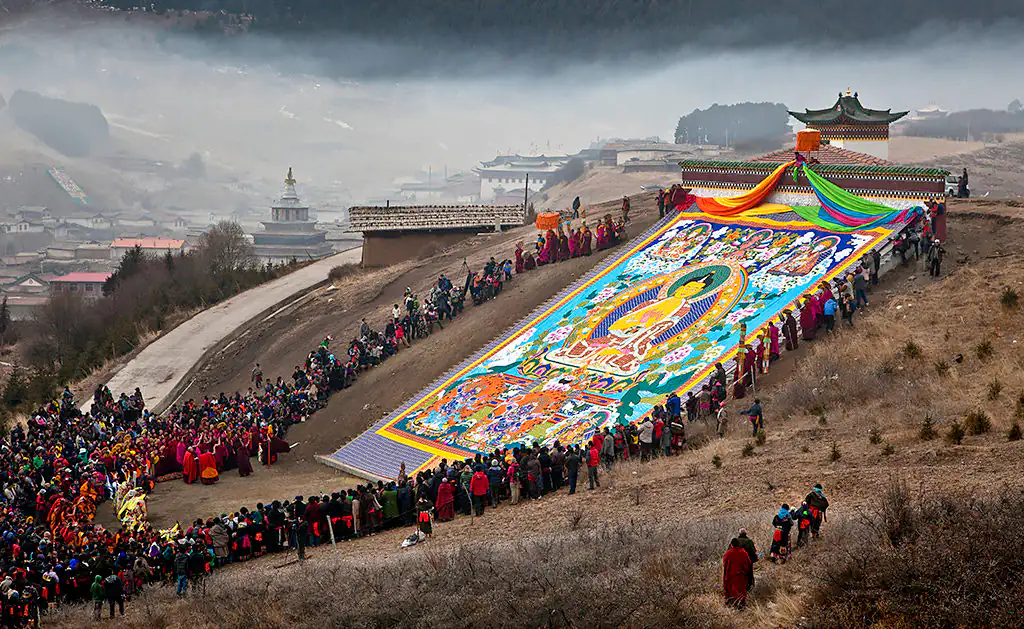
6. The Butter Lamp Festival: Illuminating Faith
The Butter Lamp Festival, also known as the Tsongkhapa Butter Lamp Festival, honors Tsongkhapa, the founder of the Gelugpa school of Tibetan Buddhism. The festival features:
- Creation of Butter Sculptures: Skilled artisans create intricate butter sculptures depicting Buddhist figures and mandalas (sacred diagrams). The artistry and detail in these sculptures are remarkable, showcasing the dedication of the craftspeople.
- Monastic Rituals: Monks perform special pujas (ritual offerings) and prayers, seeking blessings and good fortune. These rituals add a layer of spiritual significance to the festival.
- Lamp Lighting: Butter lamps are lit, illuminating monasteries and creating a magical atmosphere. The sight of hundreds of glowing butter lamps is a truly awe-inspiring spectacle.
- Date: March 14, 2025
Beyond the Big Names: Unveiling Local Gems in Tibetan Festivals
Tibetan festivals are more than just national celebrations. They encompass a vibrant tapestry of regional and local traditions, offering a deeper dive into Tibetan culture and traditions. While Losar, Saga Dawa, and Shoton grab the spotlight, numerous smaller festivals pulsate with unique customs and vibrant energy. Let’s explore two such gems: Tsechu and Nangma.
7. Tsechu: A Kaleidoscope of Regional Delights
Tsechu is not a single festival but a family of regional celebrations held throughout Tibet. Each region celebrates Tsechu at a specific time, often coinciding with the harvest season. Here’s what makes Tsechu so unique:
- Rich Local History: Each Tsechu festival boasts its unique history and traditions, reflecting the cultural heritage of its specific region.
- Ritual Dances and Masked Performances: A captivating highlight of Tsechu is the Cham dance, a masked performance depicting Buddhist deities and folklore. The vibrant costumes and energetic dances create a genuinely charming spectacle.
- Colorful Costumes and Masks: Tsechu is renowned for its intricate costumes adorned with rich colors and symbolic motifs. Elaborate masks depicting wrathful and peaceful deities add another layer of visual intrigue to the festivities.
8. Nangma: A Celebration of Community Spirit
Nangma is a local festival primarily observed in the Kham region of eastern Tibet. This vibrant celebration emphasizes community spirit and traditional ways of life:
- Unique Local Customs: Each Nangma celebration may have specific traditions, but common elements include music, dance, and communal activities like horse racing and archery competitions.
- Music and Dance: Traditional music plays a central role in Nangma, with instruments like the drachen (long horn) and the nangma (a lute-like instrument) filling the air with lively melodies. Energetic folk dances add to the festive atmosphere.
- Strengthening Community Bonds: Nangma serves as a time for communities to unite, strengthen social bonds, and celebrate their shared heritage.
Experiencing Local Tibetan Festivals
While local festivals like Tsechu and Nangma may be less widely known, they offer an authentic glimpse into Tibetan culture. Researching specific regional celebrations before your trip allows you to plan your visit and experience the unique customs of a particular area.
A Journey Through Tibetan Culture
Grand and local Tibetan festivals offer a captivating window into the heart and soul of Tibetan culture. Whether you witness the national grandeur of Losar or the intimate charm of a local Nangma celebration, these festivals promise an unforgettable cultural experience. Stay tuned as we explore the unique traditions and practices of Tibetan culture.
A Tapestry of Tradition: Unveiling the Essence of Tibetan Festivals
Tibetan festivals form a vibrant tapestry woven from religion, culture, and community spirit, offering captivating glimpses into the heart of Tibetan traditions throughout the year. Beyond the dazzling displays, a rich layer of activities and practices unfolds, creating a truly unforgettable experience. Let’s explore the key elements that bring Tibetan festivals to life.
A Feast for the Senses: Music and Dance
Traditional music and dance are the lifeblood of Tibetan festivals. Enchanting melodies played on instruments like the drachen (longhorn) and the ribs (oboe) fill the air. Energetic folk dances, often depicting stories or embodying Buddhist deities, erupt in a kaleidoscope of color and movement. Witnessing these performances allows you to appreciate the artistic heritage and vibrant spirit of Tibetan culture.
Spiritual Significance: Ceremonies and Rituals
Religious ceremonies and rituals are central to many Tibetan festivals. Monks clad in colorful robes chant prayers, perform elaborate pujas (offerings), and participate in debates on Buddhist scriptures. These practices showcase the deep religious beliefs that permeate Tibetan life and offer a window into the spiritual significance of the festivals.
Artful Expression: Thangka Paintings and Butter Sculptures
Tibetan festivals showcase exquisite traditional artistry. Thangka paintings, intricate silk scrolls depicting Buddhist deities, and mandalas are often displayed or commissioned during festivals. Additionally, the creation of dazzling butter sculptures, a remarkable display of craftsmanship, is a highlight of certain festivals, like the Butter Lamp Festival. These artistic expressions add a layer of visual wonder to the celebrations.
Culinary Delights: Local Cuisine and Festive Foods
Food plays a vital role in Tibetan festivals. Unique dishes are prepared for each occasion, offering a taste of local specialties. The culinary scene reflects regional variations and festive traditions, from savory stews like thukpa to sweet pastries in shape. Participating in a celebratory meal allows you to experience Tibetan culture through its vibrant flavors.
The Heart of the Celebrations: Monasteries and Monks
Monasteries serve as the focal point of many Tibetan festivals. They are the stage for religious ceremonies, house exquisite artwork, and provide a space for communal gatherings. Monks play a central role, leading prayers, performing rituals, and transmitting their knowledge through dances and artistic creations. Witnessing their dedication and participation deepens your understanding of the festivals’ spiritual significance.
Experiencing Tibetan Festivals
Tibetan festivals offer a distinctive opportunity to immerse yourself in Tibet’s rich culture and traditions. Researching local customs beforehand allows you to participate respectfully and appreciate the deeper meaning behind the festivities. So, the next time you plan a trip to Tibet, consider incorporating a festival into your itinerary for an unforgettable cultural experience.
A Guide to Experiencing Tibetan Festivals
Tibetan festivals are a vibrant kaleidoscope of color, music, and tradition, offering a captivating window into Tibetan culture and traditions. These celebrations punctuate the calendar, each with its unique character. Planning and understanding local customs are essential to fully experiencing the magic of Tibetan festivals. Here’s a guide to help you navigate the festive landscape of Tibet.
When to Witness the Wonder
- Losar (February/March): During the winter months, immerse yourself in the joyous celebrations of the Tibetan New Year.
- Saga Dawa (May/June): Witness the heightened piety and sacred atmosphere during this holiest month in Tibetan Buddhism.
- Monlam (December/January): Travel to Lhasa in the winter to experience the Monlam festival’s grand prayer ceremonies and public gatherings.
- Shoton (August): The summer Shoton Festival features a lively atmosphere, opera performances, and yogurt offerings.
Tips for Respectful Participation
- Cultural Etiquette: Dress modestly and avoid revealing clothing. Be mindful of religious practices and refrain from taking photos in inappropriate areas.
- Dress Code: Pack comfortable shoes suitable for walking on uneven terrain. Opt for layered clothing, as temperatures can vary. While vibrant colors are acceptable, avoid wearing clothing that mimics religious attire.
- Behavior: Be respectful during ceremonies and avoid loud talking or disruptive behavior. Always ask permission before taking photos of people.
Prime Locations for Major Festivals
- Lhasa: Witness the grand celebrations of Losar, Monlam, and Shoton in the historic capital city.
- Ganden Monastery: Travel to eastern Tibet for the spectacular Ganden Thangka Festival.
- Drepung Monastery: Experience the unique butter sculptures displayed at the Tsongkhapa Butter Lamp Festival.
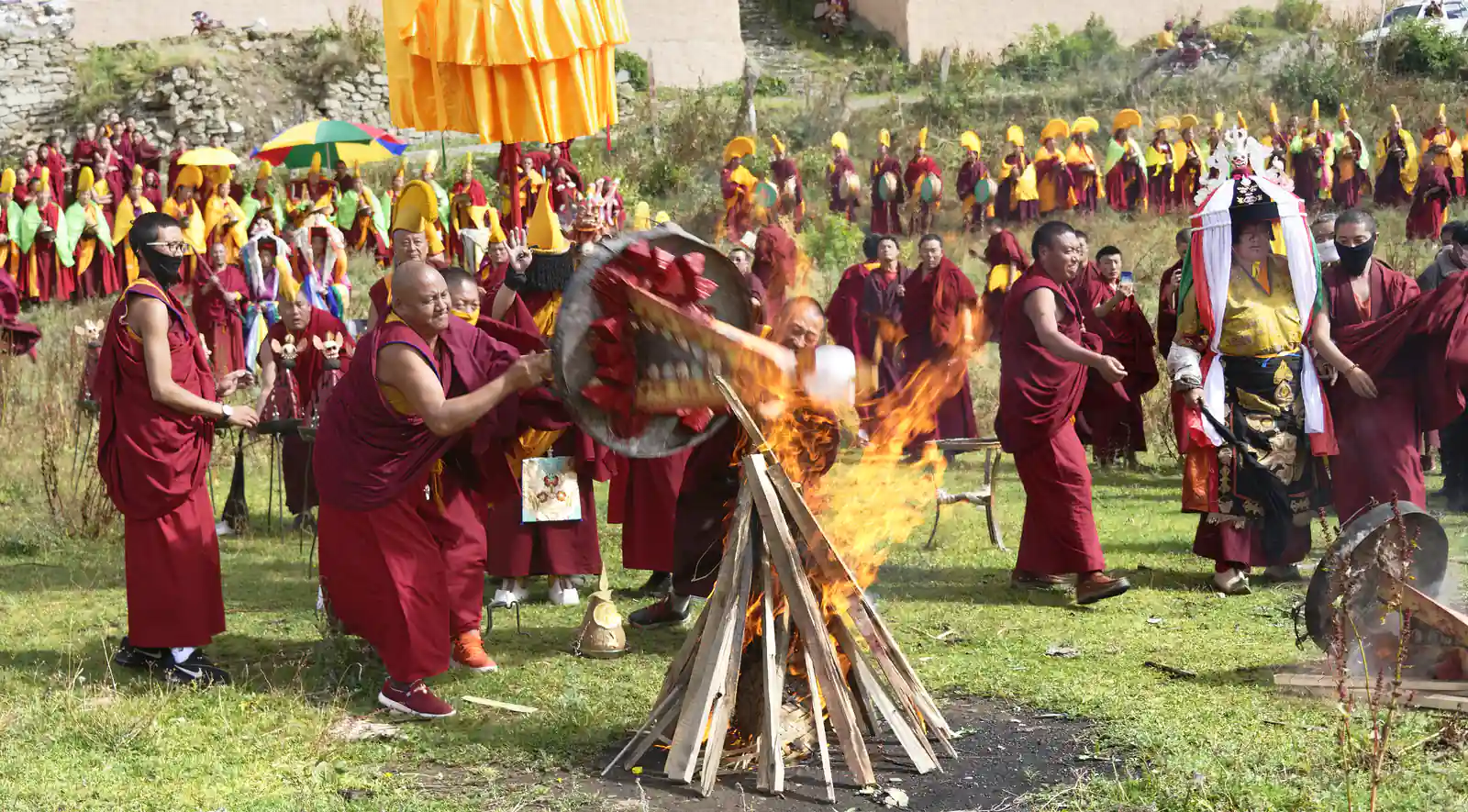
Enhancing Your Experience
Homestays: Consider a homestay experience to gain deeper insight into local traditions and daily life surrounding a festival.
Guided Tours: Choose a guided tour with an informed local guide for a respectful experience and an explanation of the cultural importance of the festivities.
The Enduring Magic: Personal Encounters with Tibetan Festivals
Tibetan festivals are more than just celebrations; they are vibrant expressions of a culture steeped in tradition. Attending these festivals allows travelers to connect with the heart of Tibetan life in a way that transcends guidebooks and tourist attractions. Let’s explore the magic of Tibetan festivals through the lens of personal experiences and expert insights.
Travelers Share Their Encounters
- A Losar Celebration: “The streets of Lhasa buzzed with energy during Losar. Families dressed in their finest clothes exchanged greetings, and the scent of burning incense filled the air. Witnessing the monks’ blessings and the joyful atmosphere left a lasting impression on me.” – Sarah W., travel blogger.
- The Spiritual Power of Saga Dawa: “The reverence during Saga Dawa was palpable. Pilgrims circumambulated the Jokhang temple in Lhasa, their faces etched with devotion. Participating in group prayers instilled a sense of peace and connection to something larger than myself.” – David M., yoga instructor.
- Shoton’s Vibrant Tapestry: “The open-air opera performances during Shoton were mesmerizing. The colorful costumes, dramatic music, and captivating stories transported me to another world. The shared laughter and joy of the crowd were infectious.” – Emily L., photographer.
Insights from Local Experts
- Tenzin, a Tibetan monk, says Festivals bring communities together, strengthen bonds, and celebrate a shared heritage. They remind us of our values and traditions and the importance of compassion and respect.
- Yangzom, a cultural anthropologist: “The intricate rituals and symbolism woven into Tibetan festivals offer a window into the Buddhist beliefs that permeate Tibetan life. Witnessing these celebrations allows for a deeper understanding of the culture.”
A Profound Impact
The cultural and spiritual impact of Tibetan festivals is undeniable. Here’s what some visitors have shared:
- “Attending the Monlam festival instilled a sense of awe. The collective energy of thousands of devotees chanting prayers was truly moving.” – Michael K., meditation practitioner.
- “Witnessing the creation of butter sculptures during the Butter Lamp Festival was a revelation. The artistry and dedication of the craftspeople were awe-inspiring.” – Li Mei, artist.
- “Participating in a local Tsechu festival allowed me to experience the unique customs of a specific region. The warmth and hospitality of the people were unforgettable.” – Alexei P., filmmaker.
A Practical Guide to Experiencing Tibetan Festivals
Tibetan festivals are a vibrant tapestry woven from religion, culture, and community spirit. These celebrations offer a glimpse into the heart of Tibetan traditions, captivating visitors with their unique blend of music, dance, and spiritual significance. However, practical considerations are essential for travelers planning to experience the magic firsthand. This guide equips you with the knowledge needed to navigate the logistics, ensure a respectful visit, and enjoy an unforgettable trip.
Planning Your Tibetan Festival Adventure
- Visas and Permits: All foreign travelers must obtain a Tibet Travel Permit (TTP). Arrange this through a registered Tibetan travel agency well in advance, as processing times can vary. Remember to get a Chinese visa for entry into China.
- Travel Logistics: Limited direct flights operate to Lhasa, the Tibetan capital. Flying via major Chinese cities like Beijing or Chengdu is often necessary. Public transportation within Tibet is limited, so consider pre-arranging tours or private drivers for efficient travel between festival locations.
Finding Your Tibetan Festival Home
- Hotels: There are several hotels in Lhasa, ranging in price from low-cost choices to high-end lodging. Make your reservations well in advance to guarantee your stay during significant festivals.
- Homestays: Consider a homestay for a more profound cultural experience. Homestays offer a unique chance to connect with local families and gain insights into daily life during a festival.
Staying Safe and Healthy
- Altitude Sickness: Tibet’s high altitude can cause altitude sickness. Gradual acclimatization is essential. Consult your doctor regarding altitude medication and be aware of the symptoms.
- Respecting Local Customs: Dress modestly and avoid revealing clothing. Lhasa has many hotels, with prices ranging from affordable options to luxurious lodging. To ensure your stay during essential festivals, book well in advance.
Sustainable and Respectful Tourism
Minimize Waste: Bring reusable water bottles and avoid using single-use plastics—purchase souvenirs made in Tibet to support local businesses and artisans.
Responsible Photography: Be mindful of your camera’s impact. Avoid using flash in monasteries and ask permission before photographing people.
Conclusion
Tibetan festivals are a vibrant kaleidoscope of color, music, and tradition, offering a captivating glimpse into the heart of Tibetan culture and traditions. These celebrations, held throughout the year, resonate with a unique blend of religious fervor, artistic expression, and communal joy. From the boisterous revelry of Losar to the introspective piety of Saga Dawa, each festival unveils a distinct facet of this remarkable culture.
A Tapestry Woven with Rich Threads
Tibetan festivals are not merely celebrations; they are a living testament to the enduring spirit of Tibetan culture. Witnessing elaborate religious ceremonies, energetic folk dances, and the creation of exquisite Thangka paintings allows you to experience this rich heritage firsthand. Be it the captivating open-air operas of Shoton or the awe-inspiring butter sculptures crafted during the Butter Lamp Festival, each celebration offers a window into the soul of Tibet.
An Invitation to Cultural Discovery
Tibetans are known for their friendliness and hospitality. When you participate in a festival, you can engage respectfully and deeply with local communities and their customs. So, pack your bags with a sense of adventure and openness. Tibetan culture invites you to step beyond the guidebook and experience a trip of cultural discovery.
Preserving a Legacy for Generations
Tibetan festivals are an essential part of the rich tapestry of Tibetan culture and are not only a reason to celebrate. We support the continuation of these customs by engaging in them. Witnessing these festivals fosters a deeper appreciation for the beauty and significance of Tibetan culture, ensuring its legacy endures for generations to come.
Plan Your Unforgettable Adventure
Tibetan celebrations provide an exceptional chance to engage with a dynamic culture and make lifelong memories. Research particular events in advance, make sensible travel plans and treat the festivities decently. Tibet awaits, ready to unveil its magic to those who embrace the spirit of festivity and cultural exchange. Let the music and dance of Tibetan festivals lead you on an unforgettable adventure.
